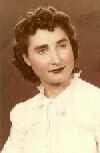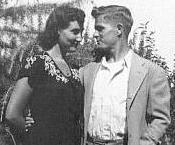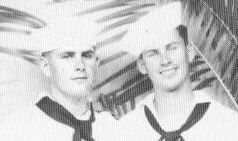 "Johnny" passed away on Dec. 16th, 2010. Information from dau., Jane Mitschele
"Johnny" passed away on Dec. 16th, 2010. Information from dau., Jane Mitschele
This story was written by his son, John W. Johnson
In February, 1944 the San Francisco teamed up with Task Force 58, a fast
carrier force, and provided air defense as aircraft from Essex, Intrepid
and Cabot decimated Truk Lagoon, and most of the ships found there. When
Frisco put into Saipan, my father was reassigned to the heavy cruiser
U.S.S. Salt Lake City CA25.
I inquired about what happened in the next few months on the Swayback Maru,
and was surprised at my father's insightful answer: You've got to remember
I was only a kid and not a full-grown man. I didn't know where I was most
of the time. It's not like they had a map and told you where you were.
Besides, there were no reference points on the ocean to go by. A lot of
times, I just didn't care where I was or I cared enough to wish I wasn't
there. It was so peaceful and beautiful, yet deadly at the same time.
We used to pray for a storm so the submarines and planes couldn't get to
us. We looked for a squall just to cool off.
If you've ever been frightened of something, and get a sick feeling in
your stomach, you can magnify that ten times and that's how it was. I
stayed that way for four years. After a while it affects you. They used
to say of someone in this condition, He's Asiatic.
At daybreak on October 25th, 1944 a superior Japanese naval force emerged
from San Bernardino straight and sped south along the Samar Coast to Leyte
Gulf. The only sentinel left guarding the US invasion area was Taffy 1, 2
and 3 of Admiral Kinkaid's seventh fleet, composed of escort carriers and
their screening destroyers. My uncle Roy, on one of the jeep carriers, as
they were known, asked, What are those ships over there?
At that moment 14-inch shells began making giant geysers all around us.
Admiral Kinkaid pleaded to Admiral Halsey for relief from his attacker.
Responsible for defending the Leyte invasion area with his Third Fleet,
Admiral Bull Halsey had been lured into engaging a decoy force north of
the Philippine's, at Cape Enjano. When Admiral Nimitz intercepted Kinkaid's
plea for help, he sent an urgent message to Admiral Halsey. It inquired,
Turkey trots to water. From Cincpac. Where is, repeat, where is Task
Force 38.4?
The World Wonders. Nimitz tried to be as delicate as he could, but he
might as well have driven a nail into his head. Halsey was real gung ho.
My dad served with Admiral Halsey in this last major naval action of the
war, in Task Force 38.4.
With the bombardment of Iwo Jima underway, the Salt Lake City took up her
assigned bombardment area. This was the last combat my father was involved
in. He served on the Sway back Maru for approximately ten months.
Participating in a contest for specialized training in the United States,
my father had won first place on the Salt Lake City. He was eventually sent
to Anacosta, Maryland for gunners school, but when he got there he was
given a choice of schools. He decided to learn how to be a
movie-projectionist instead.
My Uncle

 Frederick Trippe, Jr's
(who was awarded a Purple Heart) petty officer and friend on the Salt Lake
City. Before my dad departed from the ship in January, 1945, my uncle asked him to pay a
visit to his mother in Virginia and tell her he was all right. Dad asked
him if he had a sister and my uncle said, Yes, but you stay away from her.
She's a good girl. After that first visit, my dad would travel by train
from Anacosta to see my uncle's sister (my mother), whenever he could.
Frederick Trippe, Jr's
(who was awarded a Purple Heart) petty officer and friend on the Salt Lake
City. Before my dad departed from the ship in January, 1945, my uncle asked him to pay a
visit to his mother in Virginia and tell her he was all right. Dad asked
him if he had a sister and my uncle said, Yes, but you stay away from her.
She's a good girl. After that first visit, my dad would travel by train
from Anacosta to see my uncle's sister (my mother), whenever he could.
When my father was ordered to report to Vero Beach, Florida for small
craft landing school, he contacted Reverend Francis B. Sayre, Jr. in
Washington, D.C. He told the reverend that he didn't think his nerves
could stand any more combat. My dad didn't hear from him again, but was
assigned to Dam Neck, Virginia.
With his four years cruise up, my father received $600 from the navy to
extend the cruise for two years. He used the money to take my mother home
with him to Port Angelos, Washington to meet his family. On July
14, 1945, after only four dates in six months, my mother and father were
married. Japan surrendered while they were still honeymooning at Virginia
Beach, Virginia. My dad was so happy the war was over, he jumped in the
ocean and started to swim to England to congratulate the victors, however
he could only dog paddle! The only thing my mother could say was, Oh my
Lord!
In early 1946, my father was assigned to the fleet tanker U.S.S Passumpsic
A0107. He is a plank owner because he was in the tanker's first crew after
she was commissioned by the navy. My dad served as No.1 Master-of-Arms on
the Passumpsic by virtue of his seniority. One of his few duties was to
check on the ammunition magazine every so often. Sometimes he would tear
down his 20mm gun, and reassemble it, just to have something to do. So,
with few responsibilities, my dad spent much of his time sitting in a
covered walkway, outside the crews quarters, just thinking. He was
depressed and wanted to go home to his new wife, my mother and their baby
boy. He thought the navy should have let him go home, after all the combat
he'd seen. The Passompsic's itinerary was to leave empty from Yokosuka,
Japan, then to go to Subic Bay in the Philippines, then to Singapore on
the tip of the Malay Peninsula. Finally, she went to Ras Tannura, Arabia
to take on fuel oil. She retraced this course going back to Yokosuka, to
dump the fuel oil. Once, the oiler went to Seoul, Korea after leaving
Japan. The ship made several of these circuits in the ten months my father
was on board. During this time, he was able to visit places he couldn't in
wartime, such as the Imperial Palace in Tokyo.
One incident that occurred while my father was on the Passumpsic was when
a crewman was late from Liberty. The sailor was put in the ship's brig on
bread and water. Dad slipped him food whenever he thought no one was
looking. Later, the captain told him that he knew every time he fed the
man.
When it was time for his discharge from the navy, in 1947, my dad said he
got his only break of the war. He was standing in a line, about 3/4 of a
football field long, waiting to be released on Goat Island, in the
San Francisco Bay. Answering a call to come to the front office, he was
greeted by Chief Yoeman Schultz, who he had served with on the San
Francisco.
Schultz said he recognized his name on the list, which is unusual. He
gave my dad a three day pass, and informed him that when he got back his
discharge papers would be ready.
The people of the city of San Francisco preserved the remnant of the San
Francisco's old battered bridge. In 1950 they constructed a memorial from
it, to Rear Admiral Daniel J. Callahan, and the officers and men who died
with him, at the Naval Battle of Guadalcanal. It is located at Point Lobos,
California, overlooking the Pacific Ocean and the Golden Gate Straits.
My father had won three battle stars by the time he was eighteen, and ten
by the time he was twenty. He was in the Naval Reserves until 1950. Soon
after my dad left the reserves, his unit was called up to fight in
the Korean War.
My Dad, McKinley Rutherford (Johnny) Johnson, Pearl Harbor Survivor.
Thank You Daddy, Johnny, Jane and Kathy
Daughters
Kathy Johnson, dau.
Jane Mitschele, dau.
Also served on the following ships during WWII:
USS San Francisco & USS Passumpsic
SLC Deck Logs
Apr. 1944
Jan. 1945
2004 SLC Reunion
|


 "Johnny" passed away on Dec. 16th, 2010. Information from dau., Jane Mitschele
"Johnny" passed away on Dec. 16th, 2010. Information from dau., Jane Mitschele


